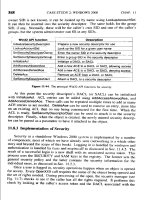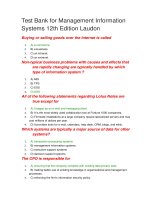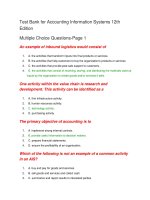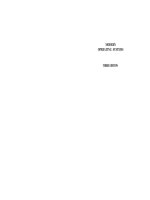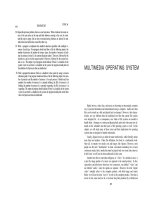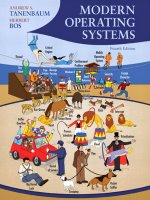Modern control systems (12th edition) richard c dorf and robert h bishop
Bạn đang xem bản rút gọn của tài liệu. Xem và tải ngay bản đầy đủ của tài liệu tại đây (7.62 MB, 753 trang )
© 2011 Pearson Education, Inc., Upper Saddle River, NJ. All rights reserved. This publication is protected by Copyright and written permission should be obtained
from the publisher prior to any prohibited reproduction, storage in a retrieval system, or transmission in any form or by any means, electronic, mechanical, photocopying,
recording, or likewise. For information regarding permission(s), write to: Rights and Permissions Department, Pearson Education, Inc., Upper Saddle River, NJ 07458.
MODERN CONTROL SYSTEMS
SOLUTION MANUAL
Richard C. Dorf
Robert H. Bishop
University of California, Davis
Marquette University
A companion to
MODERN CONTROL SYSTEMS
TWELFTH EDITION
Richard C. Dorf
Robert H. Bishop
Prentice Hall
Upper Saddle River Boston Columbus San Francisco New York
Indianapolis London Toronto Sydney Singapore Tokyo Montreal Dubai
Madrid Hong Kong Mexico City Munich Paris Amsterdam Cape Town
© 2011 Pearson Education, Inc., Upper Saddle River, NJ. All rights reserved. This publication is protected by Copyright and written permission should be obtained
from the publisher prior to any prohibited reproduction, storage in a retrieval system, or transmission in any form or by any means, electronic, mechanical, photocopying,
recording, or likewise. For information regarding permission(s), write to: Rights and Permissions Department, Pearson Education, Inc., Upper Saddle River, NJ 07458.
P R E F A C E
In each chapter, there are five problem types:
Exercises
Problems
Advanced Problems
Design Problems/Continuous Design Problem
Computer Problems
In total, there are over 1000 problems. The abundance of problems of increasing complexity gives students confidence in their problem-solving
ability as they work their way from the exercises to the design and
computer-based problems.
It is assumed that instructors (and students) have access to MATLAB
and the Control System Toolbox or to LabVIEW and the MathScript RT
Module. All of the computer solutions in this Solution Manual were developed and tested on an Apple MacBook Pro platform using MATLAB 7.6
Release 2008a and the Control System Toolbox Version 8.1 and LabVIEW
2009. It is not possible to verify each solution on all the available computer
platforms that are compatible with MATLAB and LabVIEW MathScript
RT Module. Please forward any incompatibilities you encounter with the
scripts to Prof. Bishop at the email address given below.
www.elsolucionario.org
The authors and the staff at Prentice Hall would like to establish an
open line of communication with the instructors using Modern Control
Systems. We encourage you to contact Prentice Hall with comments and
suggestions for this and future editions.
Robert H. Bishop
iii
© 2011 Pearson Education, Inc., Upper Saddle River, NJ. All rights reserved. This publication is protected by Copyright and written permission should be obtained
from the publisher prior to any prohibited reproduction, storage in a retrieval system, or transmission in any form or by any means, electronic, mechanical, photocopying,
recording, or likewise. For information regarding permission(s), write to: Rights and Permissions Department, Pearson Education, Inc., Upper Saddle River, NJ 07458.
T A B L E - O F - C O N T E N T S
1.
2.
3.
4.
5.
6.
7.
8.
9.
10.
11.
12.
13.
iv
Introduction to Control Systems . . . . . . . . . . . . . . . . . . . . . . . . . . . . . . . . . . 1
Mathematical Models of Systems . . . . . . . . . . . . . . . . . . . . . . . . . . . . . . . . 22
State Variable Models . . . . . . . . . . . . . . . . . . . . . . . . . . . . . . . . . . . . . . . . . . . 85
Feedback Control System Characteristics . . . . . . . . . . . . . . . . . . . . . . . 133
The Performance of Feedback Control Systems . . . . . . . . . . . . . . . . . 177
The Stability of Linear Feedback Systems . . . . . . . . . . . . . . . . . . . . . . 234
The Root Locus Method . . . . . . . . . . . . . . . . . . . . . . . . . . . . . . . . . . . . . . . 277
Frequency Response Methods . . . . . . . . . . . . . . . . . . . . . . . . . . . . . . . . . . 382
Stability in the Frequency Domain . . . . . . . . . . . . . . . . . . . . . . . . . . . . . 445
The Design of Feedback Control Systems . . . . . . . . . . . . . . . . . . . . . . . 519
The Design of State Variable Feedback Systems . . . . . . . . . . . . . . . . 600
Robust Control Systems . . . . . . . . . . . . . . . . . . . . . . . . . . . . . . . . . . . . . . . 659
Digital Control Systems . . . . . . . . . . . . . . . . . . . . . . . . . . . . . . . . . . . . . . . . 714
© 2011 Pearson Education, Inc., Upper Saddle River, NJ. All rights reserved. This publication is protected by Copyright and written permission should be obtained
from the publisher prior to any prohibited reproduction, storage in a retrieval system, or transmission in any form or by any means, electronic, mechanical, photocopying,
recording, or likewise. For information regarding permission(s), write to: Rights and Permissions Department, Pearson Education, Inc., Upper Saddle River, NJ 07458.
C H A P T E R
1
Introduction to Control Systems
There are, in general, no unique solutions to the following exercises and
problems. Other equally valid block diagrams may be submitted by the
student.
Exercises
E1.1
A microprocessor controlled laser system:
Controller
Process
www.elsolucionario.org
Desired
power
output
Error
-
Microprocessor
Laser
Power
Sensor
power
A driver controlled cruise control system:
Controller
Process
Foot pedal
Desired
speed
Power
out
Measurement
Measured
E1.2
Current i(t)
-
Driver
Car and
Engine
Actual
auto
speed
Measurement
Visual indication of speed
E1.3
Speedometer
Although the principle of conservation of momentum explains much of
the process of fly-casting, there does not exist a comprehensive scientific
explanation of how a fly-fisher uses the small backward and forward motion of the fly rod to cast an almost weightless fly lure long distances (the
1
© 2011 Pearson Education, Inc., Upper Saddle River, NJ. All rights reserved. This publication is protected by Copyright and written permission should be obtained
from the publisher prior to any prohibited reproduction, storage in a retrieval system, or transmission in any form or by any means, electronic, mechanical, photocopying,
recording, or likewise. For information regarding permission(s), write to: Rights and Permissions Department, Pearson Education, Inc., Upper Saddle River, NJ 07458.
2
CHAPTER 1
Introduction to Control Systems
current world-record is 236 ft). The fly lure is attached to a short invisible
leader about 15-ft long, which is in turn attached to a longer and thicker
Dacron line. The objective is cast the fly lure to a distant spot with deadeye accuracy so that the thicker part of the line touches the water first
and then the fly gently settles on the water just as an insect might.
Fly-fisher
Desired
position of
the fly
Controller
-
Wind
disturbance
Mind and
body of the
fly-fisher
Process
Rod, line,
and cast
Actual
position
of the fly
Measurement
Visual indication
of the position of
the fly
E1.4
Vision of
the fly-fisher
An autofocus camera control system:
One-way trip time for the beam
Conversion factor
(speed of light or
sound)
K1
Beam
Emitter/
Receiver
Beam return
Distance to subject
Subject
Lens focusing
motor
Lens
© 2011 Pearson Education, Inc., Upper Saddle River, NJ. All rights reserved. This publication is protected by Copyright and written permission should be obtained
from the publisher prior to any prohibited reproduction, storage in a retrieval system, or transmission in any form or by any means, electronic, mechanical, photocopying,
recording, or likewise. For information regarding permission(s), write to: Rights and Permissions Department, Pearson Education, Inc., Upper Saddle River, NJ 07458.
3
Exercises
E1.5
Tacking a sailboat as the wind shifts:
Error
Desired
sailboat
direction
-
Controller
Actuators
Sailor
Rudder and
sail adjustment
Wind
Process
Sailboat
Actual
sailboat
direction
Measurement
Measured sailboat direction
Gyro compass
E1.6
An automated highway control system merging two lanes of traffic:
Controller
Error
Desired
gap
-
Embedded
computer
Actuators
Brakes, gas or
steering
Process
Active
vehicle
Actual
gap
Measurement
www.elsolucionario.org
Measured gap
Radar
E1.7
Using the speedometer, the driver calculates the difference between the
measured speed and the desired speed. The driver throotle knob or the
brakes as necessary to adjust the speed. If the current speed is not too
much over the desired speed, the driver may let friction and gravity slow
the motorcycle down.
Controller
Desired
speed
Error
-
Driver
Actuators
Throttle or
brakes
Measurement
Visual indication of speed
Speedometer
Process
Motorcycle
Actual
motorcycle
speed
© 2011 Pearson Education, Inc., Upper Saddle River, NJ. All rights reserved. This publication is protected by Copyright and written permission should be obtained
from the publisher prior to any prohibited reproduction, storage in a retrieval system, or transmission in any form or by any means, electronic, mechanical, photocopying,
recording, or likewise. For information regarding permission(s), write to: Rights and Permissions Department, Pearson Education, Inc., Upper Saddle River, NJ 07458.
4
CHAPTER 1
E1.8
Introduction to Control Systems
Human biofeedback control system:
Controller
Desired
body
temp
Process
Hypothalumus
-
Message to
blood vessels
Actual
body
temp
Human body
Measurement
Visual indication of
body temperature
E1.9
TV display
Body sensor
E-enabled aircraft with ground-based flight path control:
Corrections to the
flight path
Desired
Flight
Path
-
Controller
Aircraft
Gc(s)
G(s)
Flight
Path
Health
Parameters
Meteorological
data
Location
and speed
Optimal
flight path
Ground-Based Computer Network
Optimal
flight path
Meteorological
data
Desired
Flight
Path
E1.10
Specified
Flight
Trajectory
Health
Parameters
Corrections to the
flight path
Gc(s)
G(s)
Controller
Aircraft
Location
and speed
Flight
Path
Unmanned aerial vehicle used for crop monitoring in an autonomous
mode:
Trajectory
error
-
Controller
UAV
Gc(s)
G(s)
Flight
Trajectory
Sensor
Location with
respect to the ground
Map
Correlation
Algorithm
Ground
photo
Camera
© 2011 Pearson Education, Inc., Upper Saddle River, NJ. All rights reserved. This publication is protected by Copyright and written permission should be obtained
from the publisher prior to any prohibited reproduction, storage in a retrieval system, or transmission in any form or by any means, electronic, mechanical, photocopying,
recording, or likewise. For information regarding permission(s), write to: Rights and Permissions Department, Pearson Education, Inc., Upper Saddle River, NJ 07458.
5
Exercises
E1.11
An inverted pendulum control system using an optical encoder to measure
the angle of the pendulum and a motor producing a control torque:
Actuator
Voltage
Error
Desired
angle
-
Controller
Process
Torque
Motor
Pendulum
Angle
Measurement
Measured
angle
E1.12
Optical
encoder
In the video game, the player can serve as both the controller and the sensor. The objective of the game might be to drive a car along a prescribed
path. The player controls the car trajectory using the joystick using the
visual queues from the game displayed on the computer monitor.
Controller
Actuator
Process
www.elsolucionario.org
Desired
game
objective
Error
-
Player
Joystick
Measurement
Player
(eyesight, tactile, etc.)
Video game
Game
objective
© 2011 Pearson Education, Inc., Upper Saddle River, NJ. All rights reserved. This publication is protected by Copyright and written permission should be obtained
from the publisher prior to any prohibited reproduction, storage in a retrieval system, or transmission in any form or by any means, electronic, mechanical, photocopying,
recording, or likewise. For information regarding permission(s), write to: Rights and Permissions Department, Pearson Education, Inc., Upper Saddle River, NJ 07458.
6
CHAPTER 1
Introduction to Control Systems
Problems
P1.1
Desired
temperature
set by the
driver
An automobile interior cabin temperature control system block diagram:
Error
-
Controller
Process
Thermostat and
air conditioning
unit
Automobile
cabin
Automobile
cabin temperature
Measurement
Measured temperature
P1.2
Temperature
sensor
A human operator controlled valve system:
Controller
Process
Error *
Desired
fluid
output *
-
Tank
Valve
Fluid
output
Measurement
Visual indication
of fluid output *
Meter
* = operator functions
P1.3
A chemical composition control block diagram:
Controller
Process
Error
Desired
chemical
composition
-
Mixer tube
Valve
Measurement
Measured chemical
composition
Infrared analyzer
Chemical
composition
© 2011 Pearson Education, Inc., Upper Saddle River, NJ. All rights reserved. This publication is protected by Copyright and written permission should be obtained
from the publisher prior to any prohibited reproduction, storage in a retrieval system, or transmission in any form or by any means, electronic, mechanical, photocopying,
recording, or likewise. For information regarding permission(s), write to: Rights and Permissions Department, Pearson Education, Inc., Upper Saddle River, NJ 07458.
7
Problems
P1.4
A nuclear reactor control block diagram:
Controller
Process
Error
Desired
power level
Reactor
and rods
Motor and
amplifier
-
Output
power level
Measurement
Measured chemical
composition
P1.5
A light seeking control system to track the sun:
Measurement
Light
source
Dual
Photocells
Ionization chamber
Controller
Ligh
intensity
Trajectory
Planner
Desired
carriage
position
Controller
-
Process
Motor
inputs
Error
Motor,
carriage,
and gears
K
Photocell
carriage
position
www.elsolucionario.org
P1.6
If you assume that increasing worker’s wages results in increased prices,
then by delaying or falsifying cost-of-living data you could reduce or eliminate the pressure to increase worker’s wages, thus stabilizing prices. This
would work only if there were no other factors forcing the cost-of-living
up. Government price and wage economic guidelines would take the place
of additional “controllers” in the block diagram, as shown in the block
diagram.
Controller
Process
Market-based prices
Initial
wages
-
Industry
Government
price
guidelines
Controller
Wage increases
Government
wage
guidelines
Cost-of-living
K1
Prices
© 2011 Pearson Education, Inc., Upper Saddle River, NJ. All rights reserved. This publication is protected by Copyright and written permission should be obtained
from the publisher prior to any prohibited reproduction, storage in a retrieval system, or transmission in any form or by any means, electronic, mechanical, photocopying,
recording, or likewise. For information regarding permission(s), write to: Rights and Permissions Department, Pearson Education, Inc., Upper Saddle River, NJ 07458.
8
CHAPTER 1
P1.7
Introduction to Control Systems
Assume that the cannon fires initially at exactly 5:00 p.m.. We have a
positive feedback system. Denote by ∆t the time lost per day, and the
net time error by ET . Then the follwoing relationships hold:
∆t = 4/3 min. + 3 min. = 13/3 min.
and
ET = 12 days × 13/3 min./day .
Therefore, the net time error after 15 days is
ET = 52 min.
P1.8
The student-teacher learning process:
Process
Controller
Lectures
Error
Desired
knowledge
-
Teacher
Knowledge
Student
Measurement
Exams
Measured knowledge
P1.9
A human arm control system:
Process
Controller
u
Desired
arm
location
e
y
s
Brain
Nerve signals
z
Measurement
Visual indication of
arm location
Pressure
Eyes and
pressure
receptors
Arm &
muscles
d
Arm
location
© 2011 Pearson Education, Inc., Upper Saddle River, NJ. All rights reserved. This publication is protected by Copyright and written permission should be obtained
from the publisher prior to any prohibited reproduction, storage in a retrieval system, or transmission in any form or by any means, electronic, mechanical, photocopying,
recording, or likewise. For information regarding permission(s), write to: Rights and Permissions Department, Pearson Education, Inc., Upper Saddle River, NJ 07458.
9
Problems
P1.10
An aircraft flight path control system using GPS:
Controller
Desired
flight path
from air traffic
controllers
Actuators
Computer
Auto-pilot
Error
-
Process
Ailerons, elevators,
rudder, and
engine power
Flight
path
Aircraft
Measurement
Measured flight path
P1.11
Global Positioning
System
The accuracy of the clock is dependent upon a constant flow from the
orifice; the flow is dependent upon the height of the water in the float
tank. The height of the water is controlled by the float. The control system
controls only the height of the water. Any errors due to enlargement of
the orifice or evaporation of the water in the lower tank is not accounted
for. The control system can be seen as:
www.elsolucionario.org
Desired
height of
the water
in float tank
P1.12
-
Controller
Process
Float level
Flow from
upper tank
to float tank
Actual
height
Assume that the turret and fantail are at 90◦ , if θw = θF -90◦ . The fantail
operates on the error signal θw - θT , and as the fantail turns, it drives the
turret to turn.
y
Wind
qW = Wind angle
qF = Fantail angle
qT = Turret angle
Controller
*
qW
qF
qT
qW
*
Turret
x
-
Process
Torque
Error
Fantail
Fantail
Gears & turret
qT
© 2011 Pearson Education, Inc., Upper Saddle River, NJ. All rights reserved. This publication is protected by Copyright and written permission should be obtained
from the publisher prior to any prohibited reproduction, storage in a retrieval system, or transmission in any form or by any means, electronic, mechanical, photocopying,
recording, or likewise. For information regarding permission(s), write to: Rights and Permissions Department, Pearson Education, Inc., Upper Saddle River, NJ 07458.
10
CHAPTER 1
P1.13
Introduction to Control Systems
This scheme assumes the person adjusts the hot water for temperature
control, and then adjusts the cold water for flow rate control.
Controller
Error
Desired water
temperature
Process
Hot water
system
Valve adjust
-
Hot
water
Actual
water temperature
and flow rate
Desired water
flow rate
Cold water
system
Valve adjust
-
Cold
water
Measurement
Measured water flow
Measured water temperature
P1.14
Human: visual
and touch
If the rewards in a specific trade is greater than the average reward, there
is a positive influx of workers, since
q(t) = f1 (c(t) − r(t)).
If an influx of workers occurs, then reward in specific trade decreases,
since
c(t) = −f2 (q(t)).
Controller
Average
rewards
r(t)
P1.15
Desired
Fuel
Pressure
Error
-
f1(c(t)-r(t))
Process
q(t)
- f2(q(t))
Total of
rewards
c(t)
A computer controlled fuel injection system:
-
Controller
Process
Electronic
Control Unit
High Pressure Fuel
Supply Pump and
Electronic Fuel
Injectors
Measurement
Measured fuel pressure
Fuel Pressure
Sensor
Fuel
Pressure
© 2011 Pearson Education, Inc., Upper Saddle River, NJ. All rights reserved. This publication is protected by Copyright and written permission should be obtained
from the publisher prior to any prohibited reproduction, storage in a retrieval system, or transmission in any form or by any means, electronic, mechanical, photocopying,
recording, or likewise. For information regarding permission(s), write to: Rights and Permissions Department, Pearson Education, Inc., Upper Saddle River, NJ 07458.
11
Problems
P1.16
With the onset of a fever, the body thermostat is turned up. The body
adjusts by shivering and less blood flows to the skin surface. Aspirin acts
to lowers the thermal set-point in the brain.
Controller
Desired temperature
or set-point from body
thermostat in the brain
Process
Adjustments
within the
body
-
Body
temperature
Body
Measurement
Measured body temperature
P1.17
Internal sensor
Hitting a baseball is arguably one of the most difficult feats in all of sports.
Given that pitchers may throw the ball at speeds of 90 mph (or higher!),
batters have only about 0.1 second to make the decision to swing—with
bat speeds aproaching 90 mph. The key to hitting a baseball a long distance is to make contact with the ball with a high bat velocity. This is
more important than the bat’s weight, which is usually around 33 ounces
(compared to Ty Cobb’s bat which was 41 ounces!). Since the pitcher can
throw a variety of pitches (fast ball, curve ball, slider, etc.), a batter must
decide if the ball is going to enter the strike zone and if possible, decide
the type of pitch. The batter uses his/her vision as the sensor in the feedback loop. A high degree of eye-hand coordination is key to success—that
is, an accurate feedback control system.
www.elsolucionario.org
P1.18
Define the following variables: p = output pressure, fs = spring force
= Kx, fd = diaphragm force = Ap, and fv = valve force = fs - fd .
The motion of the valve is described by yă = fv /m where m is the valve
mass. The output pressure is proportional to the valve displacement, thus
p = cy , where c is the constant of proportionality.
Constant of
proportionality
Spring
Screw
displacement
x(t)
K
fs
-
Valve position
fv
Valve
c
y
Diaphragm area
fd
A
Output
pressure
p(t)
© 2011 Pearson Education, Inc., Upper Saddle River, NJ. All rights reserved. This publication is protected by Copyright and written permission should be obtained
from the publisher prior to any prohibited reproduction, storage in a retrieval system, or transmission in any form or by any means, electronic, mechanical, photocopying,
recording, or likewise. For information regarding permission(s), write to: Rights and Permissions Department, Pearson Education, Inc., Upper Saddle River, NJ 07458.
12
CHAPTER 1
P1.19
Introduction to Control Systems
A control system to keep a car at a given relative position offset from a
lead car:
Throttle
Position of
follower
Follower
car
Actuator
u
-
Controller
Relative
position
-
Position
of lead
Lead car
Fuel
throttle
(fuel)
Video camera
& processing
algorithms
Reference
photo
Desired relative position
P1.20
A control system for a high-performance car with an adjustable wing:
Desired
road
adhesion
-
Process
Actuator
Controller
Computer
Adjustable
wing
Road
conditions
Race Car
Road
adhesion
Measurement
Measured road adhesion
P1.21
K
Tire internal
strain gauges
A control system for a twin-lift helicopter system:
Measurement
Measured separation
distance
Desired separation
distance
-
Controller
Process
Separation distance
Pilot
Desired altitude
Radar
Helicopter
Altitude
Measurement
Measured altitude
Altimeter
© 2011 Pearson Education, Inc., Upper Saddle River, NJ. All rights reserved. This publication is protected by Copyright and written permission should be obtained
from the publisher prior to any prohibited reproduction, storage in a retrieval system, or transmission in any form or by any means, electronic, mechanical, photocopying,
recording, or likewise. For information regarding permission(s), write to: Rights and Permissions Department, Pearson Education, Inc., Upper Saddle River, NJ 07458.
13
Problems
P1.22
The desired building deflection would not necessarily be zero. Rather it
would be prescribed so that the building is allowed moderate movement
up to a point, and then active control is applied if the movement is larger
than some predetermined amount.
Process
Controller
Desired
deflection
Hydraulic
stiffeners
-
Building
Deflection
Measurement
Measured deflection
P1.23
Strain gauges
on truss structure
K
The human-like face of the robot might have micro-actuators placed at
strategic points on the interior of the malleable facial structure. Cooperative control of the micro-actuators would then enable the robot to achieve
various facial expressions.
www.elsolucionario.org
Controller
Process
Error
Desired
actuator
position
-
Voltage
Electromechanical
actuator
Amplifier
Actuator
position
Measurement
Position
sensor
Measured position
P1.24
We might envision a sensor embedded in a “gutter” at the base of the
windshield which measures water levels—higher water levels corresponds
to higher intensity rain. This information would be used to modulate the
wiper blade speed.
Process
Controller
Desired
wiper speed
Wiper blade
and motor
Electronic
Control Unit
-
Measurement
K
Measured water level
Water depth
sensor
Wiper
blade
speed
© 2011 Pearson Education, Inc., Upper Saddle River, NJ. All rights reserved. This publication is protected by Copyright and written permission should be obtained
from the publisher prior to any prohibited reproduction, storage in a retrieval system, or transmission in any form or by any means, electronic, mechanical, photocopying,
recording, or likewise. For information regarding permission(s), write to: Rights and Permissions Department, Pearson Education, Inc., Upper Saddle River, NJ 07458.
14
CHAPTER 1
Introduction to Control Systems
A feedback control system for the space traffic control:
P1.25
Controller
Error
Desired
orbit position
Control
law
-
Actuator
Jet
commands
Process
Applied
forces
Reaction
control jets
Satellite
Actual
orbit position
Measurement
Measured orbit position
Radar or GPS
Earth-based control of a microrover to point the camera:
P1.26
Microrover
Camera position
command
Receiver/
Transmitter
Controller
G(s)
Gc(s)
Rover
position
Camera
Camera
Position
m
Ca
ap
er
Sensor
ea
iti
os
M
Measured camera
position
on
d
re
su
d
an
m
m
co
ap
er
m
ca
on
iti
os
P1.27
Desired
Charge
Level
Control of a methanol fuel cell:
-
Controller
Recharging
System
Gc(s)
GR(s)
Methanol water
solution
G(s)
Sensor
Measured charge level
Fuel Cell
H(s)
Charge
Level
© 2011 Pearson Education, Inc., Upper Saddle River, NJ. All rights reserved. This publication is protected by Copyright and written permission should be obtained
from the publisher prior to any prohibited reproduction, storage in a retrieval system, or transmission in any form or by any means, electronic, mechanical, photocopying,
recording, or likewise. For information regarding permission(s), write to: Rights and Permissions Department, Pearson Education, Inc., Upper Saddle River, NJ 07458.
15
Advanced Problems
Advanced Problems
AP1.1
Control of a robotic microsurgical device:
Microsurgical
robotic manipulator
Controller
Desired
End-effector
Position
-
G(s)
Gc(s)
End-effector
Position
Sensor
H(s)
AP1.2
An advanced wind energy system viewed as a mechatronic system:
AERODYNAMIC DESIGN
STRUCTURAL DESIGN OF THE TOWER
ELECTRICAL AND POWER SYSTEMS
www.elsolucionario.org
SENSORS
Rotor rotational sensor
Wind speed and direction sensor
ACTUATORS
Motors for manipulatiing the propeller pitch
Physical System Modeling
CONTROL SYSTEM DESIGN AND ANALYSIS
ELECTRICAL SYSTEM DESIGN AND ANALYSIS
POWER GENERATION AND STORAGE
Sensors and Actuators
WIND ENERGY
SYSTEM
Software and
Data Acquisition
CONTROLLER ALGORITHMS
DATA ACQUISTION: WIND SPEED AND DIRECTION
ROTOR ANGULAR SPEED
PROPELLOR PITCH ANGLE
AP1.3
Signals and Systems
Computers and
Logic Systems
COMPUTER EQUIPMENT FOR CONTROLLING THE SYSTEM
SAFETY MONITORING SYSTEMS
The automatic parallel parking system might use multiple ultrasound
sensors to measure distances to the parked automobiles and the curb.
The sensor measurements would be processed by an on-board computer
to determine the steering wheel, accelerator, and brake inputs to avoid
collision and to properly align the vehicle in the desired space.
© 2011 Pearson Education, Inc., Upper Saddle River, NJ. All rights reserved. This publication is protected by Copyright and written permission should be obtained
from the publisher prior to any prohibited reproduction, storage in a retrieval system, or transmission in any form or by any means, electronic, mechanical, photocopying,
recording, or likewise. For information regarding permission(s), write to: Rights and Permissions Department, Pearson Education, Inc., Upper Saddle River, NJ 07458.
16
CHAPTER 1
Introduction to Control Systems
Even though the sensors may accurately measure the distance between
the two parked vehicles, there will be a problem if the available space is
not big enough to accommodate the parking car.
Controller
Desired
automobile
position
Error
Actuators
On-board
computer
-
Steering wheel,
accelerator, and
brake
Process
Actual
automobile
position
Automobile
Measurement
Position of automobile
relative to parked cars
and curb
Ultrasound
There are various control methods that can be considered, including placing the controller in the feedforward loop (as in Figure 1.3). The adaptive
optics block diagram below shows the controller in the feedback loop, as
an alternative control system architecture.
AP1.4
Process
Astronomical
object
Uncompensated
image
Astronomical
telescope
mirror
Compensated
image
Measurement
Wavefront
reconstructor
Wavefront
corrector
Wavefront
sensor
Actuator & controller
AP1.5
Desired
floor
Error
-
The control system might have an inner loop for controlling the acceleration and an outer loop to reach the desired floor level precisely.
Controller #2
Outer
Loop
Desired
acceleration
Error
-
Controller #1
Elevator
motor,
cables, etc.
Inner
Loop
Measured acceleration
Acceleration
Measurement
Elevator
Floor
© 2011 Pearson Education, Inc., Upper Saddle River, NJ. All rights reserved. This publication is protected by Copyright and written permission should be obtained
from the publisher prior to any prohibited reproduction, storage in a retrieval system, or transmission in any form or by any means, electronic, mechanical, photocopying,
recording, or likewise. For information regarding permission(s), write to: Rights and Permissions Department, Pearson Education, Inc., Upper Saddle River, NJ 07458.
17
Advanced Problems
An obstacle avoidance control system would keep the robotic vacuum
cleaner from colliding with furniture but it would not necessarily put the
vacuum cleaner on an optimal path to reach the entire floor. This would
require another sensor to measure position in the room, a digital map of
the room layout, and a control system in the outer loop.
AP1.6
Process
Desired
distance
from
obstacles
Error
-
Controller
Measured distance from obstacle
Motors,
wheels, etc.
Robotic
vacuum
cleaner
Infrared
sensors
www.elsolucionario.org
Distance
from
obstacles
© 2011 Pearson Education, Inc., Upper Saddle River, NJ. All rights reserved. This publication is protected by Copyright and written permission should be obtained
from the publisher prior to any prohibited reproduction, storage in a retrieval system, or transmission in any form or by any means, electronic, mechanical, photocopying,
recording, or likewise. For information regarding permission(s), write to: Rights and Permissions Department, Pearson Education, Inc., Upper Saddle River, NJ 07458.
18
CHAPTER 1
Introduction to Control Systems
Design Problems
CDP1.1
The machine tool with the movable table in a feedback control configuration:
Controller
Error
Desired
position
x
Amplifier
-
Actuator
Process
Machine
tool with
table
Positioning
motor
Actual
position
x
Measurement
Position sensor
Measured position
DP1.1
Use the stereo system and amplifiers to cancel out the noise by emitting
signals 180◦ out of phase with the noise.
Process
Controller
Noise
signal
Desired
noise = 0
Shift phase
by 180 deg
-
Machine
tool with
table
Positioning
motor
Noise in
cabin
Measurement
Microphone
DP1.2
Desired
speed
of auto
set by
driver
1/K
An automobile cruise control system:
Controller
Desired
shaft
speed
-
Electric
motor
Process
Automobile
and engine
Valve
Measurement
Measured shaft speed
Shaft speed
sensor
Drive shaf t speed
K
Actual
speed
of auto
© 2011 Pearson Education, Inc., Upper Saddle River, NJ. All rights reserved. This publication is protected by Copyright and written permission should be obtained
from the publisher prior to any prohibited reproduction, storage in a retrieval system, or transmission in any form or by any means, electronic, mechanical, photocopying,
recording, or likewise. For information regarding permission(s), write to: Rights and Permissions Department, Pearson Education, Inc., Upper Saddle River, NJ 07458.
19
Design Problems
DP1.3
An automoted cow milking system:
Measurement
Cow location
Vision system
Motor and
gears
-
Desired cup
location
Process
Actuator
Controller
Location
of cup
Robot arm and
cup gripper
Cow and
milker
Milk
Measurement
Vision system
Measured cup location
DP1.4
A feedback control system for a robot welder:
Controller
Process
Computer and
amplifier
Error
Voltage
Motor and
arm
www.elsolucionario.org
Desired
position
-
Weld
top
position
Measurement
Vision camera
Measured position
DP1.5
A control system for one wheel of a traction control system:
Antislip
controller
Engine torque
+
-
Wheel
dynamics
+
-
Wheel
speed
Sensor
+
Actual slip
1/Rw
Vehicle
dynamics
Brake torque
+
Vehicle speed
Antiskid
controller
Rw = Radius of wheel
Sensor
Measured
slip
© 2011 Pearson Education, Inc., Upper Saddle River, NJ. All rights reserved. This publication is protected by Copyright and written permission should be obtained
from the publisher prior to any prohibited reproduction, storage in a retrieval system, or transmission in any form or by any means, electronic, mechanical, photocopying,
recording, or likewise. For information regarding permission(s), write to: Rights and Permissions Department, Pearson Education, Inc., Upper Saddle River, NJ 07458.
20
CHAPTER 1
Introduction to Control Systems
A vibration damping system for the Hubble Space Telescope:
DP1.6
Controller
Desired
jitter = 0
Error
Computer
-
Actuators
Gyro and
reaction wheels
Process
Signal to
cancel the jitter
Spacecraft
dynamics
Jitter of
vibration
Measurement
Measurement of 0.05 Hz jitter
DP1.7
A control system for a nanorobot:
Controller
Desired
nanorobot
position
Rate gyro
sensor
Error
-
Biocomputer
Actuators
Plane surfaces
and propellers
Process
Nanorobot
Actual
nanorobot
position
Measurement
External beacons
Many concepts from underwater robotics can be applied to nanorobotics
within the bloodstream. For example, plane surfaces and propellers can
provide the required actuation with screw drives providing the propulsion. The nanorobots can use signals from beacons located outside the
skin as sensors to determine their position. The nanorobots use energy
from the chemical reaction of oxygen and glucose available in the human
body. The control system requires a bio-computer–an innovation that is
not yet available.
For further reading, see A. Cavalcanti, L. Rosen, L. C. Kretly, M. Rosenfeld, and S. Einav, “Nanorobotic Challenges n Biomedical Application,
Design, and Control,” IEEE ICECS Intl Conf. on Electronics, Circuits
and Systems, Tel-Aviv, Israel, December 2004.
DP1.8
The feedback control system might use gyros and/or accelerometers to
measure angle change and assuming the HTV was originally in the vertical
position, the feedback would retain the vertical position using commands
to motors and other actuators that produced torques and could move the
HTV forward and backward.
© 2011 Pearson Education, Inc., Upper Saddle River, NJ. All rights reserved. This publication is protected by Copyright and written permission should be obtained
from the publisher prior to any prohibited reproduction, storage in a retrieval system, or transmission in any form or by any means, electronic, mechanical, photocopying,
recording, or likewise. For information regarding permission(s), write to: Rights and Permissions Department, Pearson Education, Inc., Upper Saddle River, NJ 07458.
21
Design Problems
Process
Desired angle
from vertical (0o)
Error
-
Controller
Measured angle from vertical
Motors,
wheels, etc.
HTV
Gyros &
accelerometers
www.elsolucionario.org
Angle from
vertical

